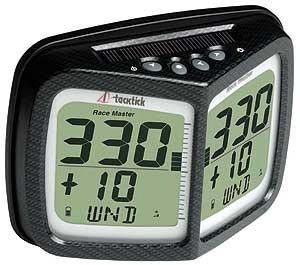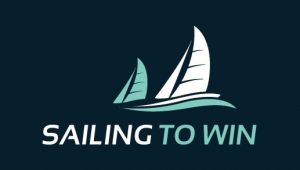

When racing around a set or fixed marks course, a competitive sailor uses the compass to plan and then implement their race strategy. Using a Compass For Course Racing
If you are sailing in a crewed boat, one crew member should be responsible to watch the compass. This establishes what the wind is doing leaving the helmsman to concentrate on boatspeed.
The compass should be mounted so that all on board can easily see it from their normal sailing positions.
Non-Electronic Compass
With a non-electronic compass, it is easier to work out tacking angles without having to resort to arithmetic. With an electronic compass, it is easier to write on the deck when you establish a median heading.
Generally with a coloured and segmented compass remembering headings seems to be easier.
Whichever type of compass you use, paint or Magic marker on the boat near the compass a large – sign on the starboard side and a large + sign on the port side. These remind you that when upwind on Starboard tack if the heading is going down you are being headed and if on Port tack upwind the heading is going up, you are being headed.
Communication is paramount and when sailing upwind, the crew should read aloud the variations away from the port or starboard mean either up or down as the breeze swings, the skipper will know ahead of time if he may need to tack or continue on.
Calling The Compass
These calls need to be evenly spaced. About five to twenty seconds is best so that an accurate picture of the swings or oscillations is established. This way the skipper knows whether the swing is on the way “up” or on the way “down”.
Only if there were a tactical or strategic reason for giving away distance, would you sail on when the reading is bad. You may be heading towards a shore where a known lift occurs through the bending of the breeze. You may decide to give away ten to gain twenty later. Tacking may put you on the wrong side of the fleet or in somebody’s bad air.
Where a compass is particularly handy, is if the wind increases suddenly and you don’t lift. This means the true wind has headed and you should seriously consider tacking.
It is vital once rounding the top mark that you look for the compass angle to the gate or wing mark. This depends on the type of course you are sailing if it is a triangle, you would be looking for the wing mark.
Compass Downwind
When heading downwind you tack on lifts and carry on when knocked. This is assuming that the shift doesn’t take you closer to the mark. This can happen when the course has not been set true.
Your compass is a major contributor to eliminating “guesswork”. Once you have mastered it you will wonder how you ever sailed without it.
CLICK HERE FOR MORE TIPS AND KNOWLEDGE!

